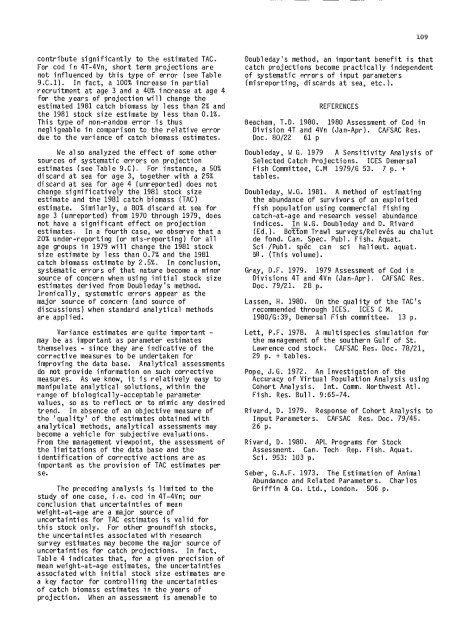Bottom Trawl Surveys - Proceedings of a Workshop Held at Ottawa ...
Bottom Trawl Surveys - Proceedings of a Workshop Held at Ottawa ...
Bottom Trawl Surveys - Proceedings of a Workshop Held at Ottawa ...
You also want an ePaper? Increase the reach of your titles
YUMPU automatically turns print PDFs into web optimized ePapers that Google loves.
contribute significantly to the estim<strong>at</strong>ed TAG.<br />
For cod in 4T -4Vn, short term projections are<br />
not influenced by this type <strong>of</strong> error (see Table<br />
9.C.1). In fact, a 100% increase in partial<br />
recruitment <strong>at</strong> age 3 and a 40% increase <strong>at</strong> age 4<br />
for the years <strong>of</strong> projection will change the<br />
estim<strong>at</strong>ed 1981 c<strong>at</strong>ch biomass by less than 2% and<br />
the 1981 stock size estim<strong>at</strong>e by less than 0.1%.<br />
This type <strong>of</strong> non-random error is thus<br />
negligeable in comparison to the rel<strong>at</strong>ive error<br />
due to the variance <strong>of</strong> c<strong>at</strong>ch biomass estim<strong>at</strong>es.<br />
We also analyzed the effect <strong>of</strong> some other<br />
sources <strong>of</strong> system<strong>at</strong>ic errors on projection<br />
estim<strong>at</strong>es (see Table 9.C). For instance, a 50%<br />
discard <strong>at</strong> sea for age 3, together with a 25%<br />
discard <strong>at</strong> sea for age 4 (unreported) does not<br />
change signific<strong>at</strong>ively the 1981 stock size<br />
estim<strong>at</strong>e and the 1981 c<strong>at</strong>ch biomass (TAG)<br />
estim<strong>at</strong>e. Similarly, a 80% discard <strong>at</strong> sea for<br />
age 3 (unreported) from 1970 through 1979, does<br />
not have a significant effect on projection<br />
estim<strong>at</strong>es. In a fourth case, we observe th<strong>at</strong> a<br />
20% under-reporting (or mis-reporting) for all<br />
age groups in 1979 will change the 1981 stock<br />
size estim<strong>at</strong>e by less than 0.7% and the 1981<br />
c<strong>at</strong>ch biomass estim<strong>at</strong>e by 2.5%. In conclusion,<br />
system<strong>at</strong>ic errors <strong>of</strong> th<strong>at</strong> n<strong>at</strong>ure become a minor<br />
source <strong>of</strong> concern when using initial stock size<br />
estim<strong>at</strong>es derived from Doubleday's method.<br />
Ironically, system<strong>at</strong>ic errors appear as the<br />
major source <strong>of</strong> concern (and source <strong>of</strong><br />
discussions) when standard analytical methods<br />
are applied.<br />
Variance estim<strong>at</strong>es are quite important -<br />
may be as important as parameter estim<strong>at</strong>es<br />
themselves - since they are indic<strong>at</strong>ive <strong>of</strong> the<br />
corrective measures to be undertaken for<br />
improving the d<strong>at</strong>a base. Analytical assessments<br />
do not provide inform<strong>at</strong>ion on such corrective<br />
measures. As we know, it is rel<strong>at</strong>ively easy to<br />
manipul<strong>at</strong>e analytical solutions, within the<br />
range <strong>of</strong> biologically-acceptable parameter<br />
values, so as to reflect or to mimic any desired<br />
trend. In absence <strong>of</strong> an objective measure <strong>of</strong><br />
the 'quality' <strong>of</strong> the estim<strong>at</strong>es obtained with<br />
analytical methods, analytical assessments may<br />
become a vehicle for subjective evalu<strong>at</strong>ions.<br />
From the management viewpoint, the assessment <strong>of</strong><br />
the limit<strong>at</strong>ions <strong>of</strong> the d<strong>at</strong>a base and the<br />
identific<strong>at</strong>ion <strong>of</strong> corrective actions are as<br />
important as the provision <strong>of</strong> TAG estim<strong>at</strong>es per<br />
se.<br />
The preceding analysis is limited to the<br />
study <strong>of</strong> one case, i.e. cod in 4T-4Vn; our<br />
conclusion th<strong>at</strong> uncertainties <strong>of</strong> mean<br />
weight-<strong>at</strong>-age are a major source <strong>of</strong><br />
uncertainties for TAG estim<strong>at</strong>es is valid for<br />
this stock only. For other groundfish stocks,<br />
the uncertainties associ<strong>at</strong>ed with research<br />
survey estim<strong>at</strong>es may become the major source <strong>of</strong><br />
u ncerta inti es for c<strong>at</strong>ch projections. In fact,<br />
Table 4 indic<strong>at</strong>es th<strong>at</strong>, for a given precision <strong>of</strong><br />
mean weight-<strong>at</strong>-age estim<strong>at</strong>es, the uncertainties<br />
associ<strong>at</strong>ed with initial stock size estim<strong>at</strong>e.s are<br />
a key factor for controlling the uncertainties<br />
<strong>of</strong> c<strong>at</strong>ch biomass estim<strong>at</strong>es in the years <strong>of</strong><br />
projection. When an assessment is amenable to<br />
109<br />
Doubleday's method, an important benefit is th<strong>at</strong><br />
c<strong>at</strong>ch projections become practically independent<br />
<strong>of</strong> system<strong>at</strong>ic errors <strong>of</strong> input parameters<br />
(misreporting, discards <strong>at</strong> sea, etc.).<br />
REFERENCES<br />
Beacham, T.D. 1980. 1980 Assessment <strong>of</strong> Cod in<br />
Division 4T and 4Vn (Jan-Apr). CAFSAC Res.<br />
Doc. 80/22 61 p<br />
Doubleday, W G. 1979 A Sensitivity Analysis <strong>of</strong><br />
Selected C<strong>at</strong>ch Projections. ICES Demersal<br />
Fish Committee, C.M 1979/G 53. 7 p. +<br />
tables.<br />
Doubleday, W.G. 1981. A method <strong>of</strong> estim<strong>at</strong>ing<br />
the abundance <strong>of</strong> survivors <strong>of</strong> an exploited<br />
fish popul<strong>at</strong>ion using commercial fishing<br />
c<strong>at</strong>ch-<strong>at</strong>-age and research vessel abundance<br />
indices. In W.G. Doubleday and D. Rivard<br />
(Ed.). <strong>Bottom</strong> <strong>Trawl</strong> surveys/Releves au chalut<br />
de fond. Can. Spec. Publ. Fish. Aqu<strong>at</strong>.<br />
Sci ./Publ. spec can sci halieut. aqu<strong>at</strong>.<br />
58 . (This vo 1 ume l .<br />
Gray, D.F. 1979. 1979 Assessment <strong>of</strong> Cod in<br />
Divisions 4T and 4Vn (Jan··Apr). CAFSAC Res.<br />
Doc. 79/21. 28 p.<br />
Lassen, H. 1980. On the quality <strong>of</strong> the TAG's<br />
recommended through ICES. ICES C M.<br />
1980/G:39, Demersal Fish committee. 13 p.<br />
Lett, P.F. 1978. A multispecies simul<strong>at</strong>ion for<br />
the management <strong>of</strong> the southern Gulf <strong>of</strong> St.<br />
Lawrence cod stock. CAFSAC Res. Doc. 78/21,<br />
29 p. + tables.<br />
Pope, J.G. 1972. An Investig<strong>at</strong>ion <strong>of</strong> the<br />
Accuracy <strong>of</strong> Virtual Popul<strong>at</strong>ion Analysis using<br />
Cohort Analysis. Int. Comm. Northwest Atl.<br />
Fish. Res. Bull. 9:65-74.<br />
Rivard, D. 1979. Response <strong>of</strong> Cohort Analysis to<br />
Input Parameters. CAFSAC Res. Doc. 79/45.<br />
26 p.<br />
Rivard, D. 1980. APL Programs for Stock<br />
Assessment. Can. Tech. Rep. Fish. Aqu<strong>at</strong>.<br />
Sci. 953: 103 p.<br />
Seber, G.A.F. 1973. The Estim<strong>at</strong>ion <strong>of</strong> Animal<br />
Abundance and Rel<strong>at</strong>ed Parameters. Charles<br />
Griffin & Co. Ltd., London. 506 p.

















